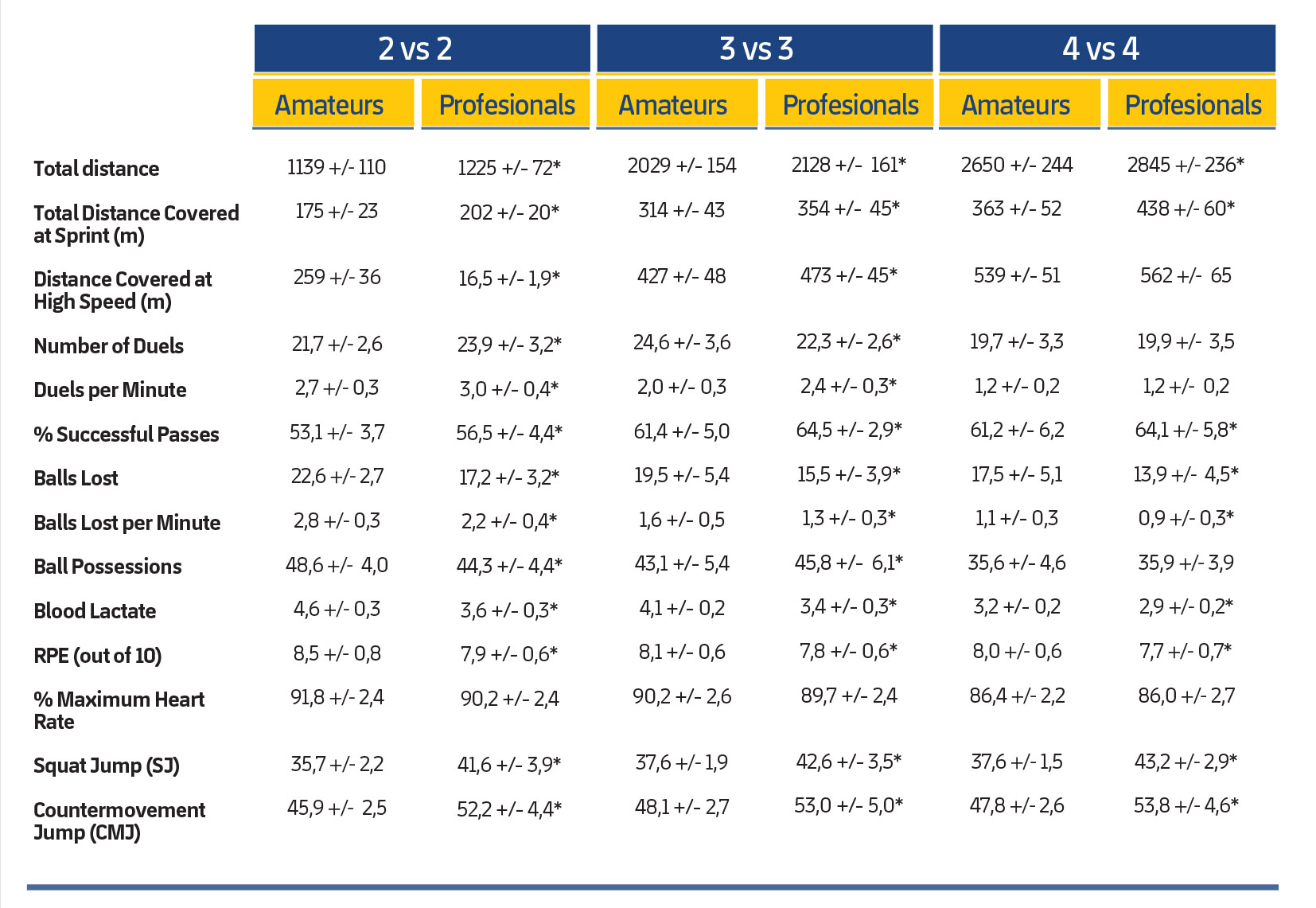July 3, 2019
Performance
Sports Performance
Team Sports
SMALL-SIDED GAMES IN FOOTBALL. ARE ADAPTATIONS THE SAME FOR PROFESSIONAL PLAYERS AND AMATEURS?
Small-sided games (SSG) are very common training tasks for any team. SSGs are matches where the number of players and the playing space are reduced in order to increase footballer participation. This makes the match more intense than an 11 vs. 11 match. We know a lot about the possibilities for adaptation that these SSGs can offer, depending on their characteristics.1,2 The intensity of these exercises can be manipulated or affected by various factors, including the number of players involved, the size and shape of the playing space, the duration of the exercise and recovery period, the rules of the game, the coach’s enthusiasm and the method of scoring a point or goal. Clearly, the potential SSG adaptations depend on the specific conditions in which they are being played.
One of the least studied areas is the effect of SSGs in relation to the level of the players. Few studies have researched the differences in response to this type of task for footballers at lower levels. As often occurs with other areas of study in football, our understanding is based on research carried out on samples of elite sportspeople. However, the methodology and exercises used by professional teams are soon taken on by teams in other categories. Are we sure that the effects will be the same?
A study published some time ago may give us clearer answers.3 The objective of this study was to analyse the relationship between the playing level (amateur vs. professional) and the physiological, physical and technical-tactical impact in three SSGs: 2 vs. 2, 3 vs. 3 and 4 vs. 4. The professional footballers belonged to a French team (n = 20) that won Ligue 1 several times and was participating in the Champions League that season. The amateurs (n = 20) played in a category equivalent to the Third Division in Spain. Table 1 shows the characteristics of the SSGs. Table 2 shows the average values and the typical deviation in each SSG after playing to one ball touch, two ball touches and free play. As can be seen, there are significant differences in almost all of the physiological responses and the physical and technical-tactical activities. Professional players are able to cover a greater distance at a higher intensity. They are more successful when passing the ball and miss significantly fewer balls. Finally, their blood lactate levels and their perceived effort are significantly lower than those of amateur players.
The results suggest that SSGs could be very useful in improving physical condition and technical-tactical abilities in footballers. However, it appears that SSGs demand different responses depending on the level of the players. The most important differences occur when tasks are carried out with just one ball touch. Coaches should allow at least two touches per possession of the ball for amateur players, due to their lower technical level. In any case, more research including study samples of semi-professional and amateur players is needed. Coaches in these categories should take the physical, physiological and technical-tactical responses of SSGs proposed in literature with caution, since they may not be useful for training their players or at the very least would need different adaptations. We should also keep in mind that there are very different playing levels within a single category. Research to improve intervention (Research-Action) is essential for any club.


Carlos Lago Peñas
REFERENCES
Hill-Haas, S., Dawson, B., Impellizzeri, F. M. and Coutts, A. (2012). Physiology of small sided games training in football. Sports Medicine, 41(3), 199-220.
2 Aguiar, M.; Botelho, G.; Lago, C.; Maças, V. and Sampaio, J. (2012). A review on the effects of soccer small-sided games. Journal of Human Kinetics 33, 103-113.
3 Dellal, A.; Hill-Hass, S.; Lago-Peñas, C. and Chamari, K. (2011). Small-sided games in soccer: amateur vs. professional players’ physiological responses, physical, and technical activities. The Journal of Strength & Conditioning Research 25 (9), 2371-2381.
KNOW MORE
CATEGORY: MARKETING, COMMUNICATION AND MANAGEMENT
This model looks to the future with the requirements and demands of a new era of stadiums, directed toward improving and fulfilling the experiences of fans and spectators, remembering “feeling” and “passion” when designing their business model.
CATEGORY: FOOTBALL SPORTS PERFORMANCE
Through the use of computer vision we can identify some shortcomings in the body orientation of players in different game situations.
CATEGORY: MEDICINE HEALTH AND WELLNESS
A health check must detect situations which, despite not showing obvious symptoms, may endanger athletes subject to the highest demands.
CATEGORY: FOOTBALL TEAM SPORTS
In the words of Johan Cruyff, “Players, in reality, have the ball for 3 minutes, on average. So, the most important thing is: what do you do during those 87 minutes when you do not have the ball? That is what determines whether you’re a good player or not.”
CATEGORY: MEDICINE HEALTH AND WELLNESS SPORTS PERFORMANCE
Muscle injuries account for more than 30% of all injuries in sports like soccer. Their significance is therefore enormous in terms of training sessions and lost game time.
DO YOU WANT TO KNOW MORE?
- SUBSCRIBE
- CONTACT
- APPLY
KEEP UP TO DATE WITH OUR NEWS
Do you have any questions about Barça Universitas?
- Startup
- Research Center
- Corporate